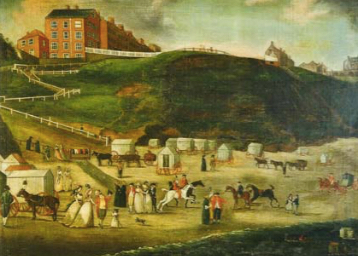Another Dip In The Sea

Taking a dip in the sea was not just prescribed for the infirm. To maintain a healthy constitution, physicians recommended that men bathe daily for five minutes before breakfast while two minutes three times a week was enough for the “weaker sex” and children. The coast also offered an attractive alternative to the tedium of everyday life, as the poet William Cowper noted in Retirement (1782); “but now alike, gay widow, virgin, wife,/ ingenious to diversify dull life,/ and all, impatient of dry land, agree/ with one consent to rush into the sea”. Offering both a mineral spa and the sea, Scarborough became one of Britain’s first, if not the first, seaside resorts by the early 18th century.
While men were able to bathe in puris naturalibus, a practice not banned until 1860, women, to preserve their modesty, entered the sea either fully clothed or in their voluminous undergarments. The idea of mixed bathing was contentious, many resorts adopting a prurient approach by segregating the beach and, by extension, the sea into men-only and women-only areas or imposing set times when one or other of the sexes could bathe.
A bathing machine provided a means for bathers to enter the sea with their dignity intact. John Setterington’s engraving of a beach scene at Scarborough from 1735, which can be seen at the town’s public library, shows an early example, a wooden hut on four wheels with a door at each end. According to Tobias Smollett (The Expedition of Humphrey Clinker (1771)), the bather climbed some wooden steps to enter the machine and undressed while a horse guided by the attendant pulled it to a point where the sea was level with its floor. The bather then plunged headlong into the sea, and when they had finished, clambered back on board to dry off, redress and be conveyed back to the shore. Benjamin Beale refined the design in 1750 by adding a large canvas hood, known as a tilt, which extended the rear of the machine and was supposed to provide extra protection from prying eyes.

A common sight on British beaches for the next 150 years, bathing machines cost six pennies to hire, plus a gratuity for the attendant. Once the bather had returned safely to the shore, the machine was hired out again, although later users would often find that the interior was wet and sandy. They only fell out of fashion towards the end of the 19th century, a recognition, to echo a correspondent to The Graphic in the 1870s, that “it is absurd that a house, a horse and an attendant are necessary to get someone into the sea”. By 1904 Scarborough had replaced them with bathing tents and the last were used in Margate in 1927.
From 1888 until 1914 Folkestone’s beach housed Walter Fagg’s patented bathing machine, two carriages, holding up to nine people each and equipped with clothes pegs, looking glasses, hat racks, wash basins, and even lavatories. Running along tracks sunk into the sand, the carriages were lifted in and out of the sea by a cable attached to a stationary steam engine.
The prospect of men and women in the sea still mortified many, one visitor to Scarborough fulminating that “mixed bathing is the halfway house to mixed sleeping and might be a plank on the river leading to the Niagara of eternal damnation”. Resorts vainly tried to impose standards, segregating beaches, and fining those who disregarded the byelaws.
An owner of a bathing machine at Lytham, according to The Preston Guardian of July 13, 1850, took three gentlemen down to an area reserved for females and received a fine of one shilling with costs of 9s.6d. for his troubles. With the railways bringing hordes of day-trippers eager to sample all that the seaside could offer, the authorities slowly began to realise that they were fighting a losing battle and most of the petty restrictions were abolished or allowed to lapse.
Apart from safety considerations, we are now free to enjoy the sea as we please. How times have changed.



